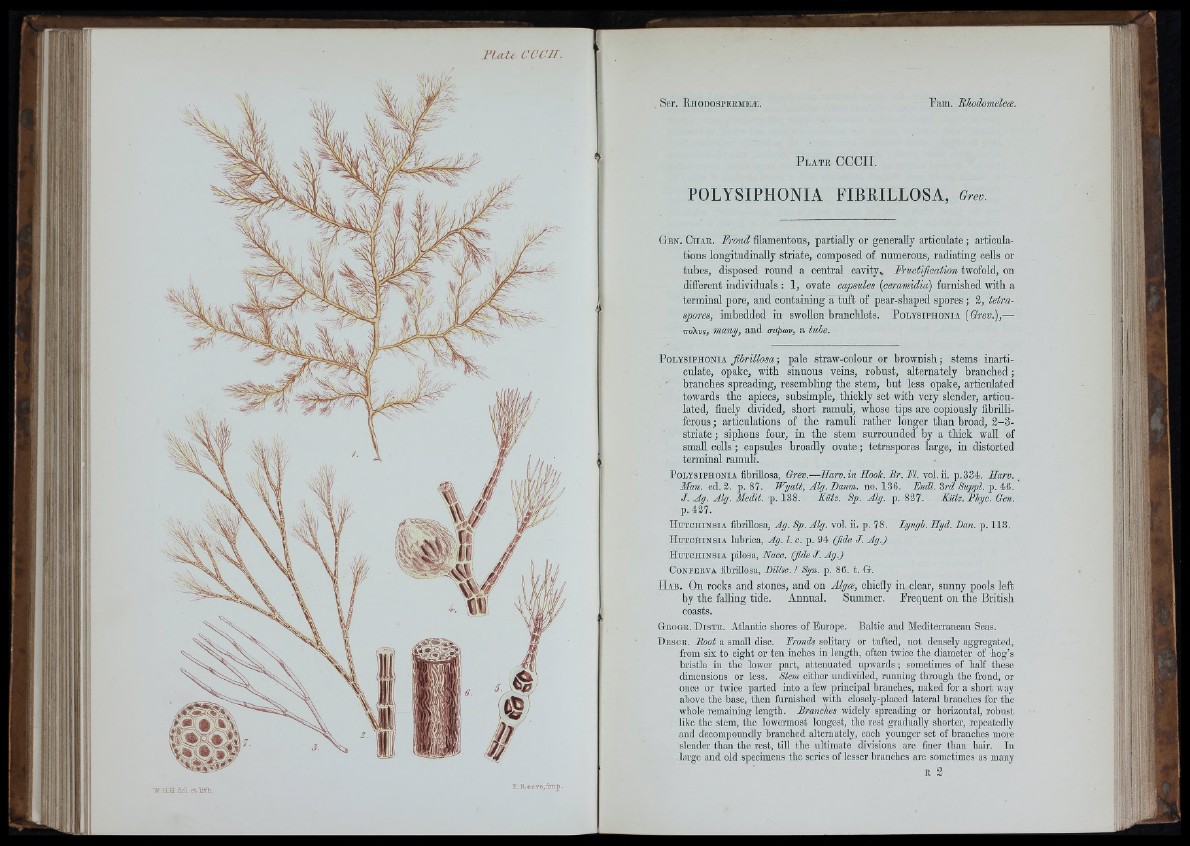
r i a t t c a c i r .
I.S.eeve,im.2.
P late C C C II.
POLYSIPHONIA FIBRILLOSA, Grev.
Gen . Ch a b. Frond filamentous, partially or generally articulate ; articulations
longitudinally striate, composed of numerous, radiating cells or
tubes, disposed round a central cavity. Fructification twofold, on
different individuals ; 1, ovate capsules {ceramidia) furnished with a
terminal pore, and containing a tu ft of pear-shaped spores ; 2, tetraspores,
imbedded in swollen branchlets. P olysiphonia {Orev) ,—
■KoXvs, many, and a tube.
P olysiphonia filrillo sa ; pale straw-colour or brownish ; stems inarticulate,
opake, with sinuous veins, robust, alternately branched ;
branches spreading, resembling the stem, but less opake, articulated
towards the apices, subsimple, thickly set with very slender, articulated,
finely divided, short ramuli, whose tips are copiously fibrilli-
ferous ; articulations of the ramuli rather longer th an broad, 2 -3 -
s tria te ; siphons four, in the stem surrounded by a thick wall of
small cells ; capsules broadly ovate ; tetraspores large, in distorted
terminal ramuli.
P olysiphonia fibrillosa, Grev.—Earv.in Hooh. Br. FI. vol.ii. p .334. Harv.
Man. ed. 2. p. 87. Wyatt, Alg. Danm. no. 136, Endl, 3rd Suppl. p. 46.
J. Ag. Alg. Medit. p. 138. Kiitz. Sp. Alg. p. 827. Kiitz. Phyc. Gen.
p. 427.
H utchinsia fibriUosa, Ag. Sp. Alg. vol. ii. p. 78. Lyngh. Eyd. Dan. p. 113.
H utchinsia lubrica, Ag. 1. c. p. 94 (fide J. Ag.)
H utchinsia pilosa, Nacc. (Jide J. Ag.)
CoNFEBVA fibrillosa, Liïlw. ! Syn. p. 86. t. G.
Hab . On rocks and stones, and on Algoe, chiefly in clear, sunny pools left
by th e falling tide. Annual. Summer. Frequent on the Britisli
coasts.
Geogk. D istk . Atlantic shores of Europe, Baltic and Mediterranean Seas.
Desck. Root a small disc. Eronds solitary or tufted, not densely aggregated,
from six to eight or ten inches in length, often twice the diameter of hog’s
bristle in the lower part, attenuated upwards ; sometimes of half these
dimensions or less. Stem either undivided, running through the frond, or
once or twice parted into a few principal branches, naked for a short way
above the base, then furnislied with closely-placed lateral branches for the
whole remaining length. Branches widely spreading or horizontal, robust
like the stem, the lowermost longest, the rest gradually shorter, repeatedly
and decompoundly branched alternately, each younger set of branches more
slender than the rest, till the ultimate divisions are finer than hair. In
large and old specimens the scries of lesser branches are sometimes as many
R